How to Grow and Care for Begonia Maculata
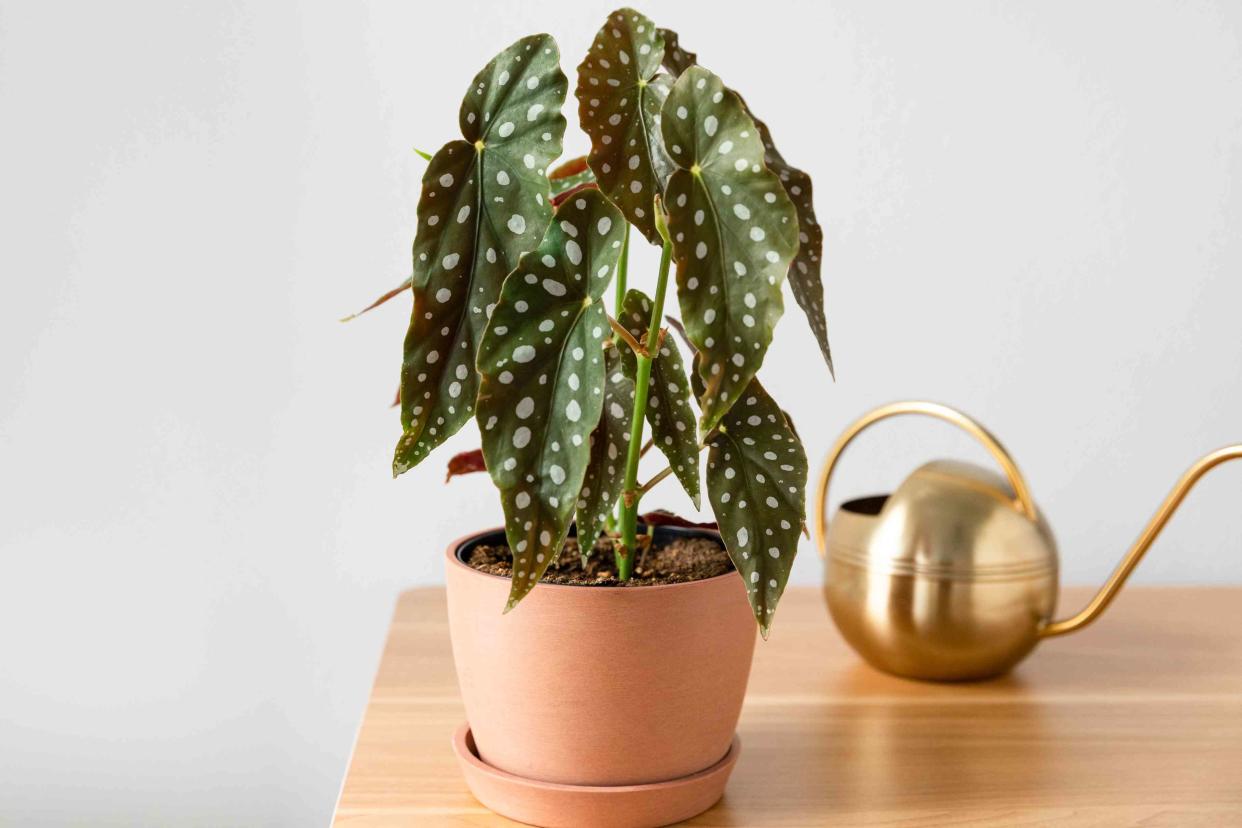
The Spruce / Anastasia Tretiak
Reviewed by Kathleen Miller
Begonia maculata, also known as the polka dot begonia, is a tropical perennial and one of the most striking begonias. The spotted, elongated leaves are a dark green color that sometimes ranges from olive to forest green. The plant's spots are a pale grey to silver color, and the undersides of the leaves are a rich burnt orange color. Begonia maculata grows best in tropical-like conditions that emulate its native areas, which means moist, rich acidic soil, average humidity, and temperatures between 65 and 70 degrees Fahrenheit. Begonia maculata is toxic to animals.
Common Name | Polka dot begonia, spotted begonia, angel wing begonia, clown begonia |
Botanical Name | Begonia maculata |
Family | Begoniaceae |
Plant Type | Tropical perennial, evergreen |
Mature Size | Up to 24 in. tall |
Sun Exposure | Sun to part shade, indirect sunlight indoors |
Soil Type | Moist, rich, well-drained, sandy loam |
Soil pH | Acidic |
Bloom Time | April to July |
Flower Color | White, pink |
Hardiness Zones | 10-12 (USDA) |
Native Areas | Asia, South Africa, Central America, Mexico |
Toxicity | Toxic to animals |
Begonia Maculata Care
Here are the main care requirements for growing Begonia maculata.
Give the plant partial or indirect sunlight.
Plant in a high-quality potting mix that is very well-draining.
Water twice a week and only if the top 1/2 inch of the soil is dry; never overwater this plant.
Offer Begonia maculata only average humidity.
Do not keep the plant in a room that goes below 60 degrees Fahrenheit.
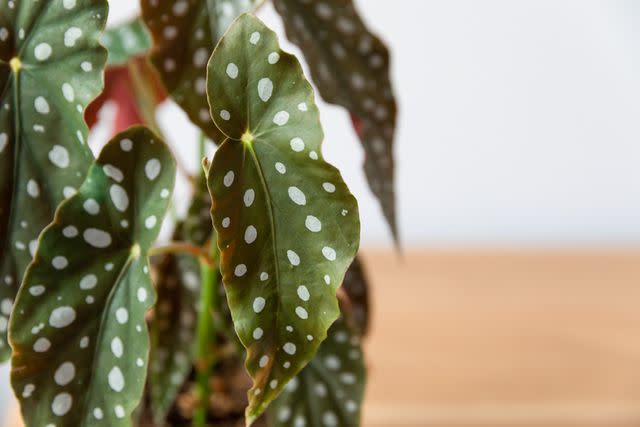
The Spruce / Anastasia Tretiak
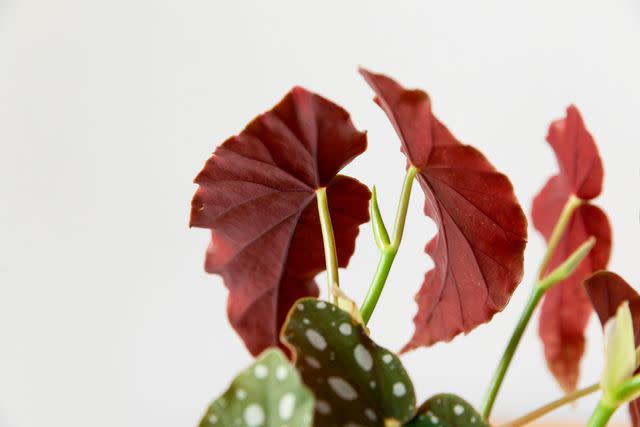
The Spruce / Anastasia Tretiak
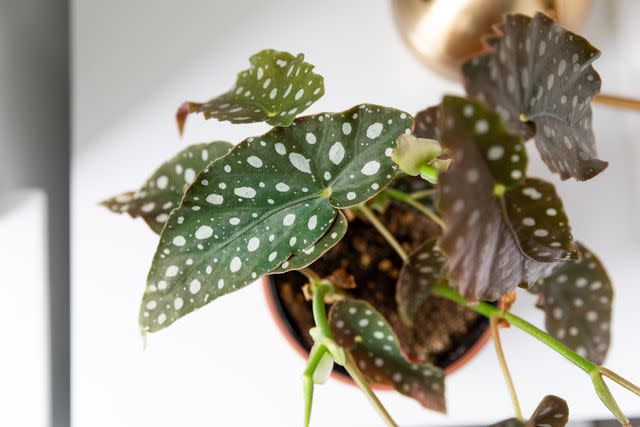
The Spruce / Anastasia Tretiak
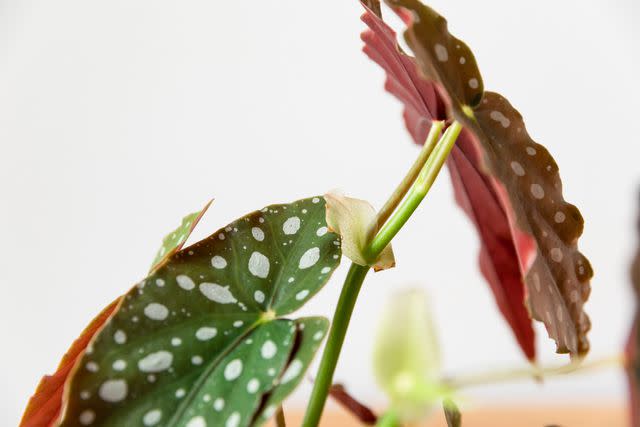
The Spruce / Anastasia Tretiak
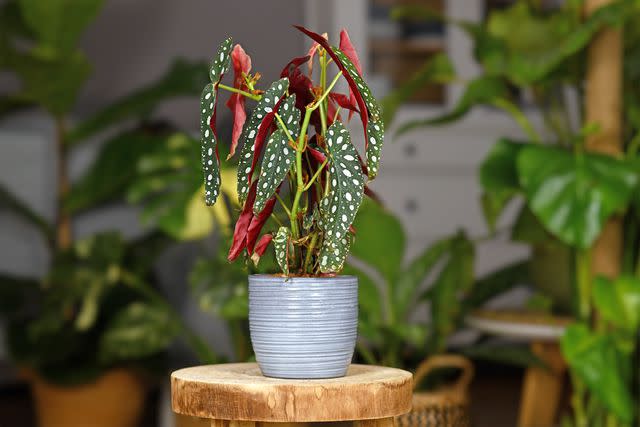
Firn / Getty Images
Light
This begonia does best in partial sunlight. Indirect sunlight is best indoors, near a window. You may want to relocate it occasionally as the sunlight moves around according to the seasons, especially in winter as daylight hours grow shorter.
Soil
The polka dot begonia prefers moist, rich soil. Since it is most often grown in containers or indoors, a good potting mix should suffice, or a sandy loam soil. Be sure there is adequate drainage; this can be improved by adding some perlite.
Water
It's very important not to overwater your begonia. Let the top 1/2 inch of soil dry out before watering. Overwatering can cause root rot which can eventually kill the plant. Watering no more than twice a week should be sufficient but this varies depending on humidity levels in your home also; you can gauge the right amount by checking the soil before watering.
Temperature and Humidity
This plant is rather fussy about its ideal temperature. Being a tropical, its perfect growing conditions should emulate its native areas. Temperatures between 65 and 70 are best. Temperatures below 60 degrees Fahrenheit can cause the plant to wilt.
Begonia maculata needs a steady level of humidity, but not too much (45 to 50 percent), so using a humidifier is advisable if your home has dry air. Placing it in or near the bathroom or kitchen will help increase the humidity levels. Placing saucers of water near the plant can help keep humidity consistent. However, too much humidity can cause problems such as mildew or fungal rot, so monitor your begonia for any issues.
Fertilizer
A fertilizer can be used to help liven up the blooms on your polka dot begonia. A basic slow-release liquid fertilizer in a 10-10-10 formula works fine; use this in spring and apply once every two to three weeks to increase blooms as needed.
Types of Begonia Maculata
Some plants in the Begonia genus may look just like Begonia maculata, such as Begonia coccinea and Begonia coralllina. Here are a few types of Begonia maculata to look for, each with varying leaves and spots:
Begonia maculata ˈWightiiˈ: This cultivar 's dark green leaves are dotted with silvery-white spots along with the signature red leaf undersides.
Begonia maculata 'Tamaya': Elongated leaves have silver spots.
Begonia maculata ‘Annan Grace’: Frillier leaves have multitudes of overlapping silver and white spots.
Begonia maculata 'Flamingo Queen': This cultivar produces bright pink flowers and silver-edged speckled leaves.
Begonia x albopicta: This hybrid is a cross between Begonia maculata and Begonia olbia and is also white-spotted.
Pruning
Your polka dot begonia also needs regular pruning to keep it from getting too overgrown or leggy. The best time to do this is late autumn or after a period of bloom when the flowers are starting to drop off and fade. Use a sharp small pair of snips to make a clean cut.
Propagating Begonia Maculata
You can propagate this plant with small cuttings. The best timing for propagation is when there are the fewest flowers on the plant, such as late winter.
Make a clean cut from the plant using scissors. Some gardeners recommend dabbing the cut spot with a bit of ground cinnamon to heal it and prevent any disease.
Place the end of the cutting (the stem, not the leaf) in a glass container with filtered water in a spot with bright but indirect light. Change the water every three to five days. The roots take a while to grow so be patient; it may take several weeks to two months.
You can then plant the rooted cutting in a container with a well-draining potting mix; water when the soil becomes dry, just as you would a mature begonia.
Potting and Repotting Begonia Maculata
As your begonia grows, you will want to transfer it into a larger container, and/or refresh the soil from time to time. Do this in early spring before the active growing season. Wait to transplant until the soil no longer feels loose in the container; gently shake old soil from the roots, and refresh the potting soil.
Common Pests & Plant Diseases
This plant is somewhat susceptible to spider mites, whiteflies, and mealybugs. Turn to insecticidal soaps or run a cotton swab saturated with rubbing alcohol over the leaves. Refreshing the soil helps cut back on unwanted pests and diseases.
Fungal diseases, such as powdery mildew, can be treated with fungicides, including neem oil. Bacterial diseases, such as leaf rot, can take hold of the plant when the bacteria infect the stems and other parts of plants. Sanitize your hands and gardening tools when working with the plant. Discard affected parts of the plant.
How to Get Begonia Maculata to Bloom
Bloom Months
Under good growing conditions, this plant normally blooms from April to July, and sometimes there is a second period of bloom in late winter (January or February). This plant can bloom up to three times per calendar year in optimal conditions.
What Does a Begonia Maculata Flower Look and Smell Like?
Begonia maculata's produces hanging clusters of small flowers that range from white to pink to coral. The blooms have a delicate, sweet fragrance.
How to Encourage More Blooms
Begonias are often thought of as shade plants but Begonia maculata needs a good amount (at least six hours) of indirect sunlight to bloom. If your window doesn't provide adequate light, add a grow light. Fertilizing too much can also prevent flower formation and instead will encourage the vigorous growth of leaves and stems only. Cut back on fertilizing to see if that produces blooms. Overwatering can also hinder blooms and can lead to root rot.
Deadheading Begonia Maculata Flowers
This plant also benefits from deadheading and clearing away of dried or rotted plant material. Keep the surface of the soil clean from debris as well.
Common Problems With Begonia Maculata
This very sensitive plant can be well worth the time and effort of figuring out its needs. Most of its issues occur if the plant is overwatered or lives in a space with too much humidity. Watch for these issues.
Drying, Pale Leaves
If you see leaves with brown patches or they are turning pale, the plant could be getting too much bright light and becoming scorched and dehydrated. Move the plant to another spot.
Wilting Leaves
The plant may not be getting enough light. It also may be overwatered. Check for root rot, as well.
White Substances on Leaves
Luckily, white spots on the bottom of the leaves are mealybugs which can be wiped off with rubbing alcohol. White powder is powdery mildew, which can be removed with a fungicide. Then discard the affected leaves and make sure the plant has enough air circulation around it.
Frequently Asked Questions
Is Begonia maculata an indoor houseplant?
For most regions, Begonia maculata is an indoor houseplant. If you live in USDA zone 10, you might be able to grow this plant outside. Some gardeners keep it outside during the warmer months and then move it indoors when nightly temperatures fall below 60 degrees Fahrenheit.
How do you take care of a Begonia maculata?
This finicky plant requires perfecting just the right amounts of moistened soil, indirect sunlight, humidity, and fertilizer.
Does Begonia maculata prefer to be misted?
Avoid misting the leaves of this plant or it could introduce fungal problems.
Read the original article on The Spruce.

